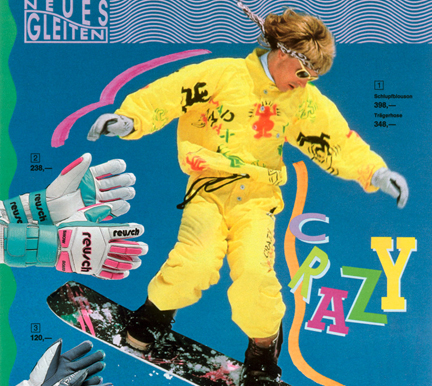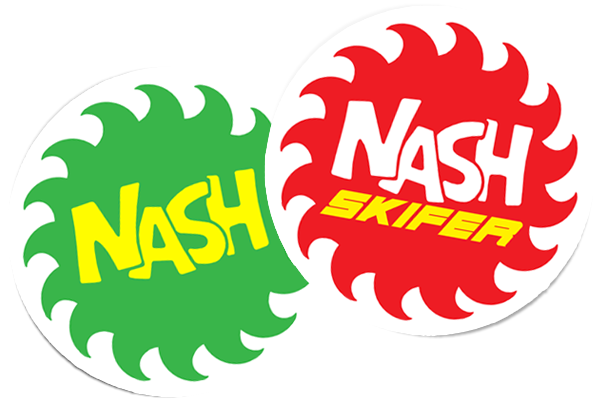A while ago we created a bunch of stickers for pioneering snowboard brands that had gone the way of the step-in. Seeing as those stickers have been selling like things that occasionally sell, we thought it would be time to produce some more. Keep an eye out for a strangely forgotten key moment in the history of snowboarding...
Crazy Banana (1983-2001ish)
Back in the midst of snowboarding's neon phase the Swiss company Crazy Banana were the European masters, but let's not fuck around with introductions, this is all you need to know about Crazy Banana.
All snowboard movies should have porn soundtracks
Here's another look at one of the featured epic ensembles. Amazing optical illusion time: Try staring at this guys crotch for 60 seconds and immediately look at a white wall.
 |
| Now a reverse image of the suit will be forever burned into your retinas. |
They also churned out some eye-wateringly incredible topsheet designs.
But as their now dormant website says, the most memorable thing about Crazy Banana snowboards was the logo:
Established in 1983 a star is born!
The positive and funny banana logo with its unique expression has quickly become one of the world's best known snowboard logos. A long lasting impression for trendy sports products.
Focusing on young and positive people. crazy banana snowboards established itself as a pioneer in the snowboard industry with a strong, striking logo in 1983.
Positive, fresh, young is our message.
 |
| "one of the world's best known snowboard logos"...you've probably never seen before |
The website has not been updated since 2001 so they didn't make it much past the millennium. The founders of Crazy Banana, and presumably they were also Die Hard baddies, Harry Gunz and Paul Gruber (the first guy to import Burton into Europe), are still going strong with their current snowboard brand Rad-Air.
Skosh (1974-1983)
The Colorado Ski & Snowboard Museum cover Skosh so succinctly I'm not going to bother writing my own summary:
Bill O’Connell, Carrie Campbell and Scott Dowell (“Skosh”) began making prototypes in 1974, using the same wood core techniques as skateboards they sold through their company, Laguna. The first boards were constructed in their garage in Littleton and tested on Loveland Pass.
Although they came from a skateboard background Skosh designs were really influenced by surfing. A lot of their boards were essentially just snowboard shaped surfboards made from foam and resin.
There were small Skosh teams in both Colorado and California, and they would mostly ride at Loveland Pass and Snow Summit, respectively. The company finished making boards in 1983, due to a lack of ski area acceptance, the death of Skosh and financial stress.
Hammarplast Ski-Board (1977)
Hammarplast, a Swedish household products company, had a brief foray onto producing a snufer-type snowboard in 1977. It was designed by industrial designer Arne Darnell and they managed to flog 70,000 boards in the first year. As we saw in our recent article the snurfer era was pretty much all over by 1977 so these guys got in on this trend a little too late, which is why unless you're a middle aged Swedish fella, you've probably never seen one of these beauties before.
 |
| Weird that no one has reintroduced the shape on the right again. |
The Snookie was a board we featured in that snurfer era article. It was impossible to finding any corroborating info or pictures of the Snookie on the internet among all the dross and pictures of some similarly-named, strangely-coloured female dwarf.
Nash Skifer (1969)
Nash started out in the late 50's making water skis...
In the 60's they were one of the first companies to start making skateboards...
And by 1969 they'd also jumped on the snurfer trend producing the Skifer.
After the Skifer they didn't stick around in snowsports but they did continue to be a pretty significant budget option in skateboarding into the 80's. The company still exists, but they're a shadow of their former might and their limited operation now seem to primarily focus on producing water skiing equivalent of snowblades.
Nash started out in the late 50's making water skis...
 |
| Sexy waterskis |
In the 60's they were one of the first companies to start making skateboards...
| back when narrow-set aluminium wheels made sure the sport was as unappealing as possible |
They didn't push the boat out much when they extended their rage into natty little scooters...
And by 1969 they'd also jumped on the snurfer trend producing the Skifer.
After the Skifer they didn't stick around in snowsports but they did continue to be a pretty significant budget option in skateboarding into the 80's. The company still exists, but they're a shadow of their former might and their limited operation now seem to primarily focus on producing water skiing equivalent of snowblades.
Checker Pig (1983-90's)
Along with all the neon, snowboarding in the 80's was also defined by a micro trend for brand names that were fully explained by their logo. Along with Crazy Banana there was Checker Pig.
 |
| and like Crazy Banana they were also purveyors of mind-warping graphics. |
Checker Pig started in 1983 in Germany and as they say on the 1999 version of the site; "Snowboards were a crazy thing, so a crazy logo was needed. It is not to be overlooked, the smiling pink pig with sunglasses logo of Checker Pig."
Checker Pig's biggest contribution to snowboarding was that they were the first company to produce a woman's pro model snowboard. It's a strangely overlooked moment in modern versions of snowboarding history. Here's an extract from a Transworld article from way back in 1995 about the history of women's snowboarding.
In the 1994-95 season, Sims was the first company to launch a full-scale marketing campaign that touted its “First Women’s Pro Model.” With Shannon Dunn’s name attached to the board; huge yellow sunflowers; and a design that catered to smaller, lighter, more aggressive riders, the board definitely appealed to women.
While Sims may have been the first to successfully market a women’s model, it wasn’t the true “first” women’s board. In the early 90s Nitro had the Petra Mussig race board, and Checker Pig had the Lisa Vinciguerra freestyle board. But both boards were short-lived.
“Signature models weren't promoted as heavily back then,” explains Chico Bukaovansky, assistant sales manager at Nitro. “And race boards really weren't something you promoted. That’s just the way it was.”
Apparently, whether the board was a race board or not made little difference for marketing. Former Checker Pig rider Lisa Vinciguerra designed the first female freestyle board. It was sold for a season in Europe, but never saw daylight in the U.S. market.
“There were a few snowboards women helped design, but Sims was the first to push a woman’s board in the U.S.,” says Vinciguerra.
A year after Checker Pig was founded they started to produce mountain bikes, two years later the two companies were split up. Today the mountain bike company is still going but the snowboard company is no more.
 |
| In another first for snowboarding, this was the only time a Deliverance reference has ever been used to advertise snowboards |
You Might Also Like...
Our look at the classic snowboards of the snurfer era was referenced a few times here.
Our first set of vintage snowboard stickers form forgotten brands
And we also have some unbranded snowboard stickers













